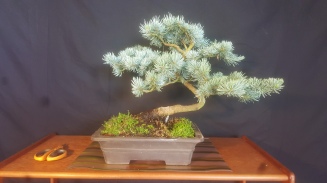
It’s been awhile since I’ve discussed bonsai matters to anyone other than my immediate family. Unfortunately none of my children have expressed any interest in my hobby. That is not to say that they are not impressed with what I’ve accomplished. They are amazed with the sheer number of trees I have and how I’ve managed to water each and everyone of them first by hand and now with drip emitters off a timer. Their questions are always: “what are you planning to do with all those trees, Dad?” or, “you should sell them. Your trees look a lot better than the ones they sell at the stores.”
My answer is that when my father sold trees years ago in San Francisco, I didn’t have the opportunity to see what would happen to them after they were shaped. And I did shape quite a few. On a productive day, without the distractions of business, I would shape up to thirty junipers, cedars or cypress in one and five gallon cans in a day.

Back then all we used was iron wire, not copper or aluminum. It got so that I knew the strength of iron wire by gauge from 16 all the way to eight. By looking at a branch I knew immediately which gauge to use. I also was able to cut a length of wire which was long enough to wire two branches as well as double wire a branch if its caliper was such that it fell between two gauges. That is to say, 12 gauge was too heavy and 14 too light. Wiring was a craft and wiring neatly became a skill. Criss-crossing or uneven coiling of a branch or stem was the mark of an amateur.
And so, I became quite adept at wiring and shaping nursery stock. That was my forte. But as I said earlier, these trees were sold within months of my wiring them.
Young nursery stock, if properly selected shape well and can be fairly attractive immediately upon wiring. This is where Mr. Yuji Yoshimura and I disagreed years ago, though our disagreement was friendly. I was convinced then, and still am today, that depending upon the species, young nursery stock (up to 5 gallon cans) does not have to look unattractive when they are initially shaped. Cedars and junipers shape quite well from the outset. Pines are more difficult to make look attractive from the start as are certain varieties of cypress and spruce.
My favorite tree for shaping is the Blue Atlas Cedar. Unfortunately, they are not readily available in one gallon containers as they were in the Fifties at Pacific Nurseries, a wholesale nursery, in Colma.

My father would buy them in lots of fifty and a hundred. They were easy to wire and could be bent hard without breaking. Junipers and cotoneasters shape easily, too. As the tree becomes older it is difficult to bend its stem so that the first bend occurs close to the root crown, That bend is the most important bend of all the other bends, since it evokes strength. A sharp bend at the base of tree with “nebari” (large surface roots) is an extremely desirable attribute when judging the artistic value of a bonsai.
And so, for me, if I were to choose a tree to train, it would be the Blue Atlas Cedar, hands down. Grafted to a Cedar of Lebanon, the roots are strong and readily adaptable to root pruning. It’s a tree, as a bonsai, that can take many forms, cascading being among my favorite.